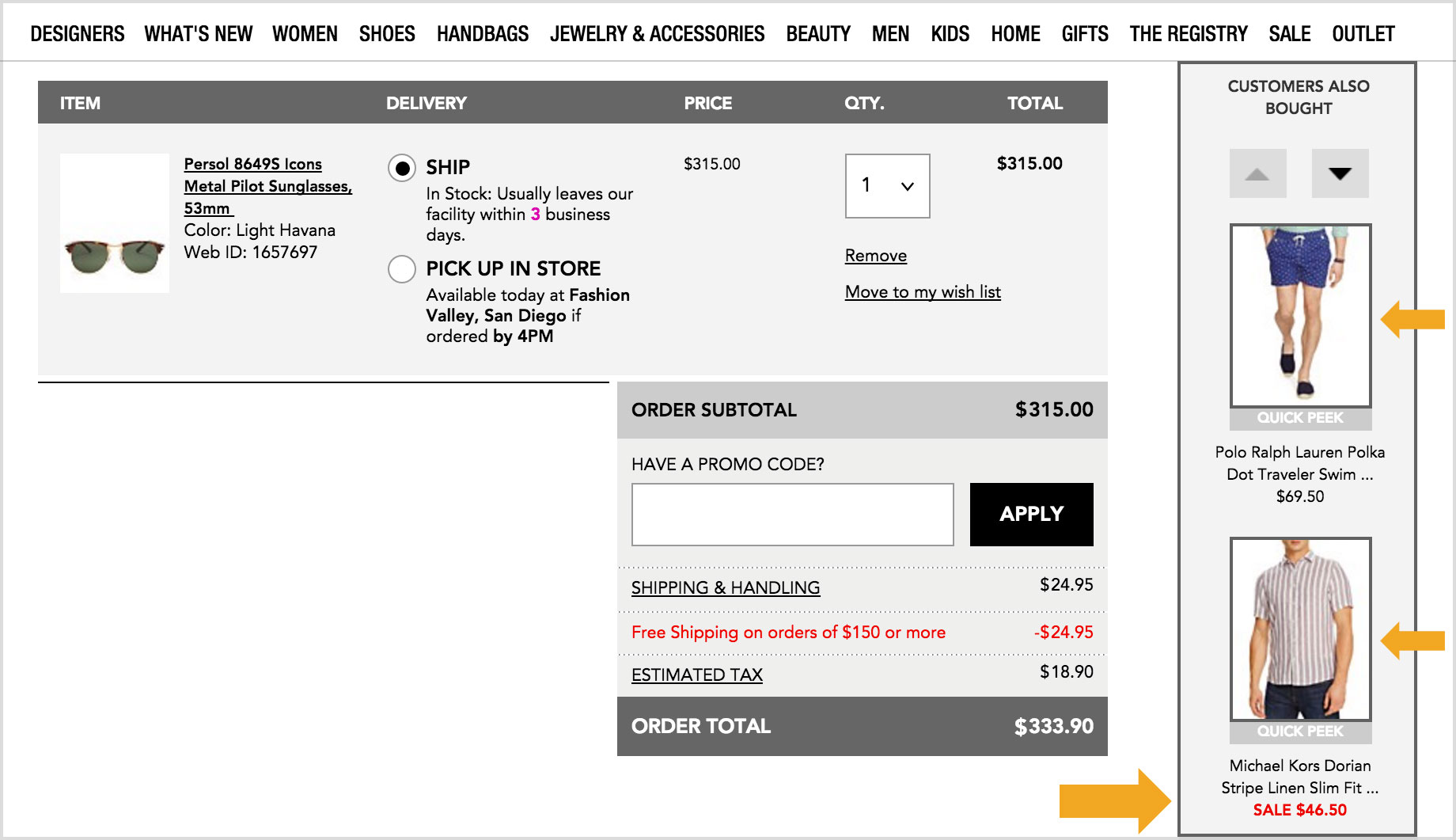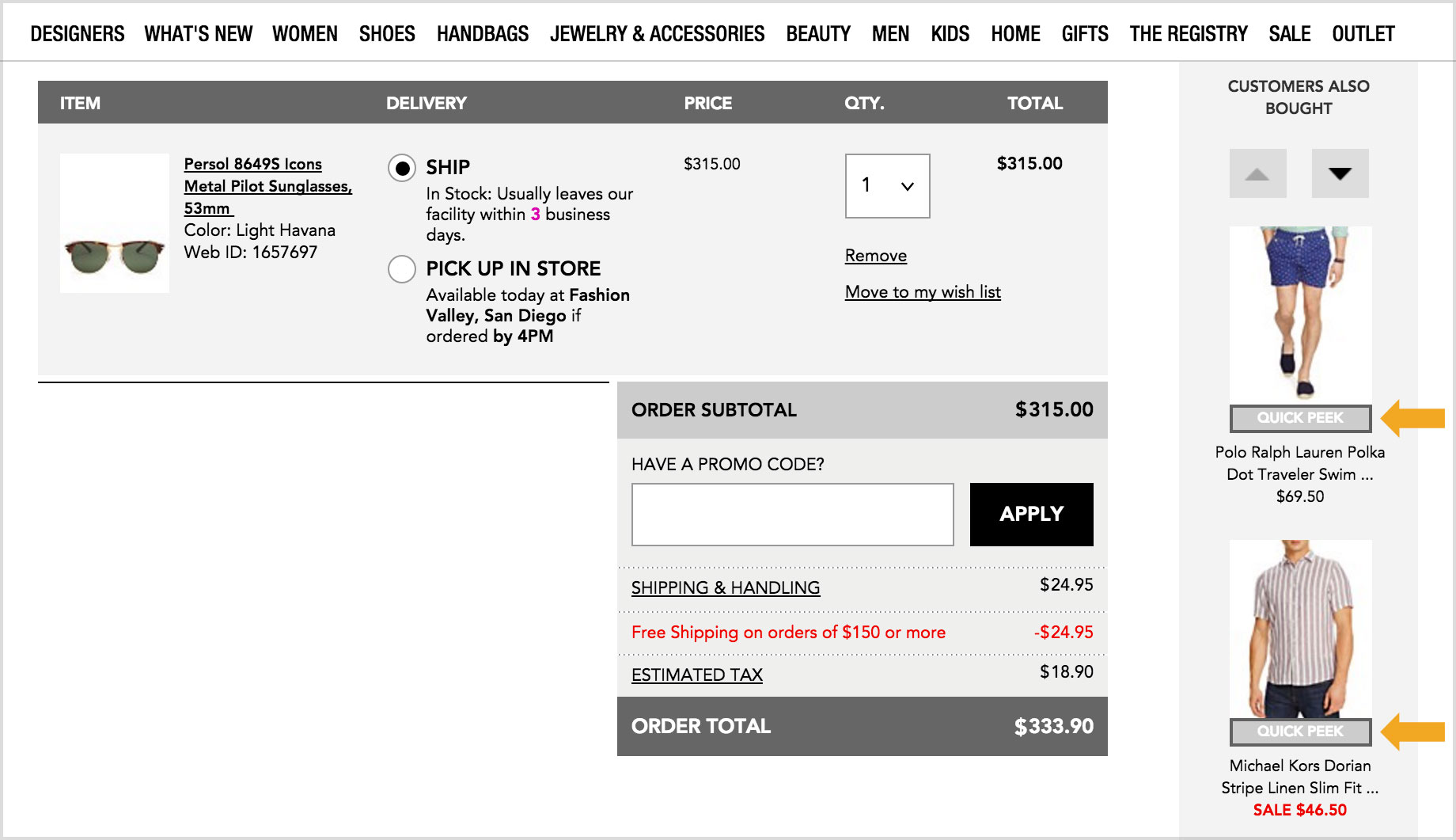You spend a lot of time optimizing your website to streamline the shopper’s path through the retail funnel—making sure they see value at each point along the way. Once you navigate the shopper to the right product, it’s important that you take the necessary steps to seal the deal, and get the shopper across the finish line.
The cart page is a pivotal area for securing that conversion. When done well, you’ll get the sale, and then potentially entice the shopper to buy more items. When done poorly, you’ll disrupt conversion by distracting the shopper from the transaction you’ve fought so hard to get.
And so we ask: How smart is your cart?
At RichRelevance, we’re sensitive to the cart page experience, and work closely with our retail partners to implement solutions deep in the funnel that will grow cart values without compromising conversion. Here are three things you can do with product recommendations to substantially enhance your cart page experience:
1. Get out of the way
Securing conversion is our primary objective on the cart page. If we can get the shopper to buy more stuff and grow the order value, that’s phenomenal! But, it shouldn’t compromise completing the sale. The location of recommendations must reflect this prioritization and not interfere with the shopper consuming information critical to the buying decision.
As such, recommendations must be on the periphery of core content such as the cart summary, checkout call-to-action, promotional code inputs, and other key messaging and functionality. This usually means slotting a vertical placement in the right margin or a horizontal placement underneath the main content area. Otherwise, if more prominently placed, you’re baiting customers to continue shopping, which can be extremely disruptive to conversion.
2. Recommend complementary, non-competitive products
When you finally get the shopper to the cart page, it’s critical not to challenge their decision to buy. If they add a TV to their shopping bag, they’ve demonstrated a degree of commitment that we shouldn’t impede by recommending another TV upon landing on the cart page. Instead of being helpful, that would be frustrating to the shopper, and elicitreconsideration at a point when a shopper should be firm about their core purchase
On the cart page, it’s imperative to use cross-sell recommendations that display products most often purchased with the seed item. However, since these kinds of recommendations rely on purchase behavior at the individual product level, something that happens much less frequently than browse activity, , it can be challenging for behavioral recommendations systems to always deliver intuitive cross-sell recommendations across a retailer’s entire catalog.
As an example, if a specific TV model has only been purchased 50 times in recent history, that’s probably not enough transactions to reliably identify four or five logical products that are commonly purchased with it. You can overcome this dilemma, in 2 ways:
I. Incorporate point-of-sale (POS) data in recommendations. If you have a brick-and-mortar presence, you probably have more offline POS transactions than online sales. Incorporating those in your online recommendations will provide a wealth of data from which to identify logical product associations.
II. Employ rule-based recommendations. Create a set of advanced merchandising rules that governs what is recommended in cross-sell situations. For each category of products, define what categories you want represented in each recommendation slot—and then let the engine source products based on whatever brand, attribute or compatibility-matching requirements you might have configured.
Ok, so now you have well-placement recommendations and you’ve optimized your cross-sell assortment across your entire catalog. What’s left?
3. Optimize your recommendations layout
Once you’ve gotten the shopper to the cart page, create inertia that pushes them through the checkout process rather than casting them out to higher parts of the funnel. You can do this by presenting a recommendation layout that facilitates exploring a product and adding it to cart without leaving the current page. Implement ‘quick view’ functionality on recommendations that allows a shopper to access product information, configuration options (e.g., size/color), and add-to-cart capabilities with a single click. Without this functionality, you’re forcing shoppers to leave the cart page to explore recommended products, and they may never come back.
Your cart page is sacred as it’s the gateway to more cash in your coffers. It’s imperative that the page experience drive shoppers to transact rather than pull them into a dangerous loop of product reconsideration. These are merely a small sample of tactics RichRelevance has deployed and validated using rigorous A/B and multivariate testing. We strongly encourage you to consider these optimizations for your retail site. They’ll make your cart smarter, protect your conversions, and grow your order values.
Malcolm Gladwell a récemment vulgarisé le terme « outlier » (valeur aberrante) en l’utilisant pour désigner des personnes performantes. Toutefois, dans le contexte des données, les valeurs aberrantes sont des points de données très éloignés d’autres points de données, c’est-à-dire atypiques… Read more
Malcolm Gladwell recently popularized the term ‘outlier’ when referring to successful individuals. In data terms, however, outliers are data points that are far removed from other data points, or flukes. Though they will make up a small portion of your total data population, ignoring their presence can jeopardize the validity of your findings. So, what exactly are outliers, how do you define them, and why are they important?
A common A/B test we like to perform here at RichRelevance is comparing a client’s site without our recommendations against with our recommendations to determine the value. A handful of observations (or even a single observation) in this type of experiment can skew the outcome of the entire test. For example, if the recommendation side of an A/B test has historically been winning by $500/day on average, an additional $500 order on the No Recommendation side will single-handedly nullify the apparent lift of the recommendations for that day.
This $500 purchase is considered an outlier. Outliers are defined as data points that strongly deviate from the rest of the observations in an experiment – the threshold for “strongly deviating” can be open to interpretation, but is typically three standard deviations away from the mean, which (for normally distributed data) are the highest/lowest 0.3% of observations.
Variation is to be expected in any experiment, but outliers deviate so far from expectations, and happen so infrequently, that they are not considered indicative of the behavior of the population. For this reason, we built our A/B/MVT reports to automatically remove outliers, using the three standard deviations from the mean method, before calculating results, mitigating possible client panic or anger caused by skewed test results from outliers.
At first glance, it may seem odd to proactively remove the most extreme 0.3% of observations in a test. Our product is designed to upsell, cross-sell, and generally increase basket size as much as possible. So, in an A/B test like the above, if recommendations drive an order from $100 to $200, that’s great news for the recommendations side of the test – but if the recommendations are so effective that they drive an order from $100 to $1,000, that’s bad news because a $100 order has become an outlier and now gets thrown out.
In order for a test to be statistically valid, all rules of the testing game should be determined before the test begins. Otherwise, we potentially expose ourselves to a whirlpool of subjectivity mid-test. Should a $500 order only count if it was directly driven by attributable recommendations? Should all $500+ orders count if there are an equal number on both sides? What if a side is still losing after including its $500+ orders? Can they be included then?
By defining outlier thresholds prior to the test (for RichRelevance tests, three standard deviations from the mean) and establishing a methodology that removes them, both the random noise and subjectivity of A/B test interpretation is significantly reduced. This is key to minimizing headaches while managing A/B tests.
Of course, understanding outliers is useful outside of A/B tests as well. If a commute typically takes 45 minutes, a 60-minute commute (i.e. a 15-minute-late employee) can be chalked up to variance. However, a three-hour commute would certainly be an outlier. While we’re not suggesting that you use hypothesis testing as grounds to discipline late employees, differentiating between statistical noise and behavior not representative of the population can aid in understanding when things are business as usual or when conditions have changed.





